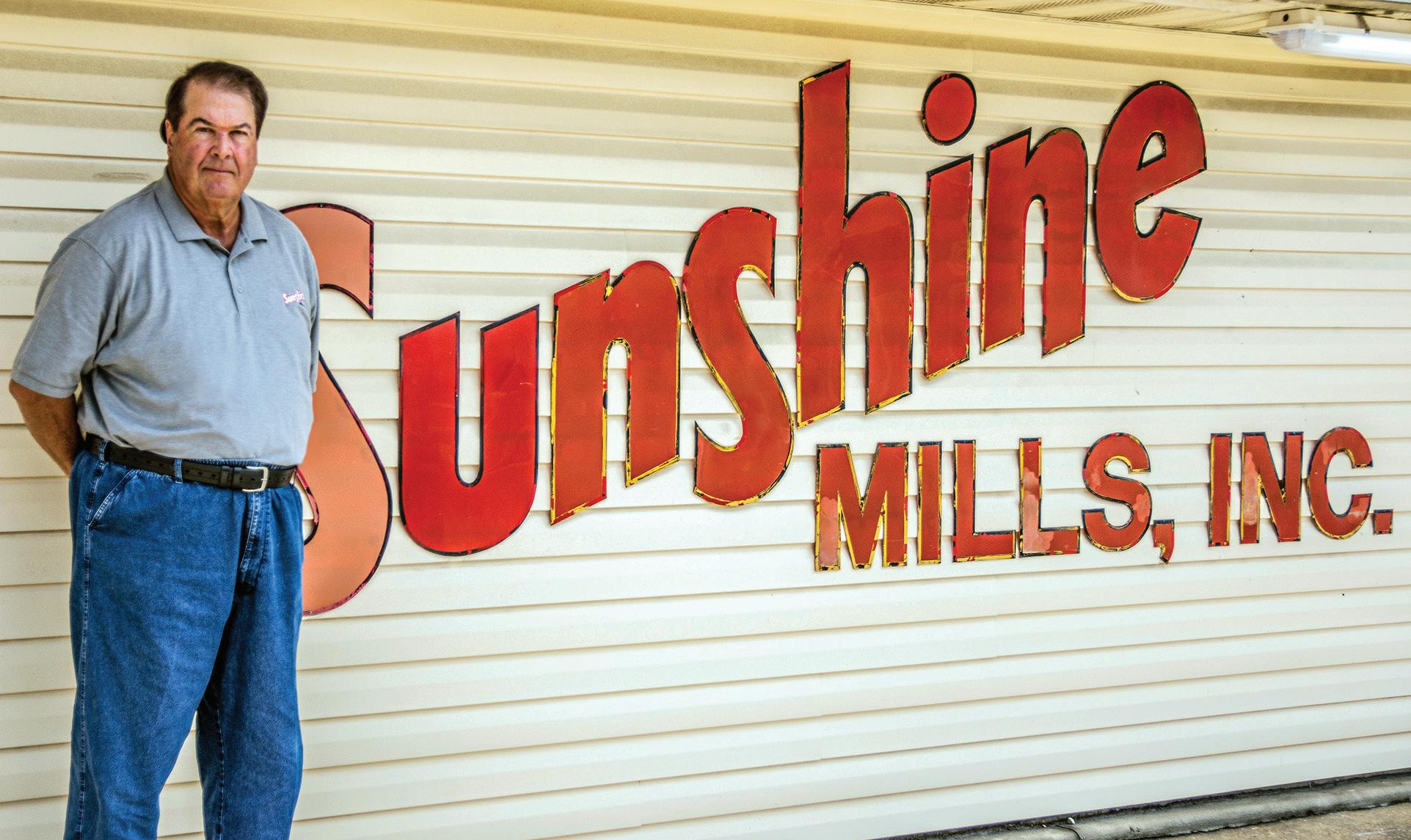
35 minute read
My tractor
Amy E. Mosley. SUBMITTED by Amy Mosley, Loxley.

Our son, Nathan, and one of our Anderton Farms’ family
tractors. SUBMITTED by Tammy Anderton, Moulton.
Those overgrown azaleas are no match for Sherry, using my
trusty Kubota. SUBMITTED BY David Deloney, Ozark.


Raybon Waters and his Massey Ferguson about to disk a turnip patch. SUBMITTED BY Myrtle Waters, Repton.

Submit “I grew this” photos by March 31. Winning photos will run in the April issue. SUBMIT to
WIN $10!
Online: alabamaliving.coop Mail: Snapshots P.O. Box 244014 Montgomery, AL 36124
Case tractor from the 1930’s.
SUBMITTED by Bill Fuller, Prattville.
RULES: Alabama Living will pay $10 for photos that best match our theme of the month. Photos may also be published on our website at alabamaliving.coop and on our Facebook and Instagram pages. Alabama Living is not responsible for lost or damaged photos. Send a self-addressed stamped envelope to have photos returned.
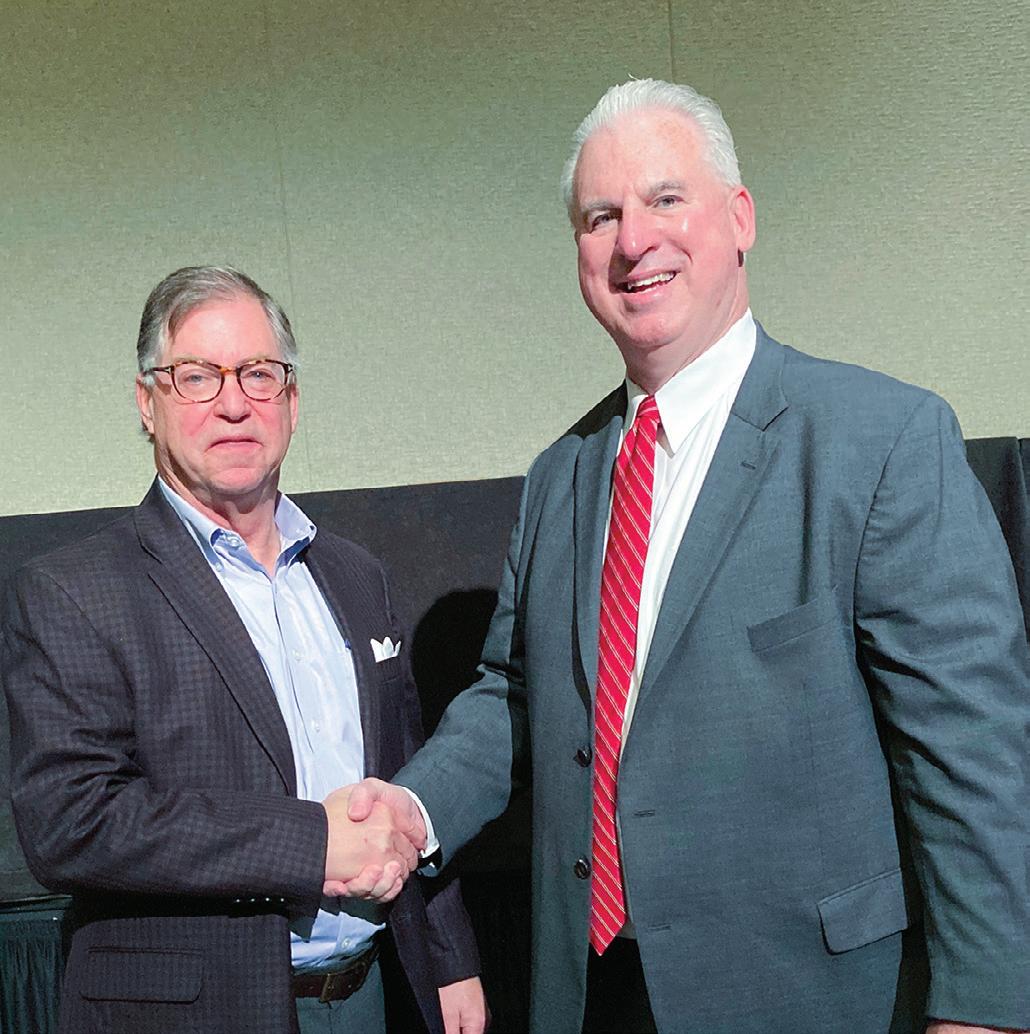
Fred Braswell, left, retiring president and CEO of AREA, congratulates new President and CEO Karl Rayborn.
The Board of Directors of the Alabama Rural Electric Association of Cooperatives has named Karl G. Rayborn as its new president and CEO. Rayborn, who had been serving as Senior Vice President & Chief Financial Officer at AREA, will replace retiring President and CEO Fred Braswell, who has served in that position for the past 22 years.
AREA is the statewide trade association serving Alabama’s 22 electric distribution cooperatives, PowerSouth Energy Cooperative and the Tennessee Valley Authority. The board’s Executive Committee conducted an extensive nationwide search process to fill the president’s position after Braswell announced his retirement in 2020. The committee’s choice of Rayborn was then approved by the full AREA board.
“The goal of our board was to identify, screen and interview as many qualified candidates as possible in order to ensure our organization will continue to maintain its great leadership,” says Board Chairman Daryl Jones, general manager of Black Warrior Electric Membership Corporation. “After more than eight months the task is complete and I congratulate Karl.” “I look forward to leading the association to support the electric cooperatives of Alabama through the changing times ahead,” Rayborn says. Rayborn, a Brantley native and Auburn University alumnus, has served the association for the last 25 years. Prior to his career with AREA, he worked with Jackson Thornton & Co. Certified Public Accountants. Braswell has served the organization since 1999. “It’s been an honor and a privilege to serve the members of Alabama’s electric cooperatives through AREA,” he says. “This is a great program with good people and I will miss serving them.”
Alabama’s 22 rural electric cooperatives deliver power to more than 1 million people, or a quarter of the state’s population, and they maintain more than 71,000 miles of power line.
Archives continues Food for Thought lecture series
Alabama’s unique history continues to be brought to life with the Alabama Department of Archives and History’s popular lunchtime lecture series, Food for Thought. Lectures are always free and are held at 12 p.m. Central Time on the third Thursday of the month.
Upcoming topics and dates: March 18, “I will not move: The story of Alabama suffragist Indiana Little,” presented by Briana Royster (this lecture is virtual only); April 15, “African Americans and higher education in Alabama, 1867-1881,” presented by Bertis English; and May 20, “Gone with the land: Environmental history of the Civil War in Alabama,” presented by Erin Mauldin.
The in-person lectures are held at the Joseph M. Farley Alabama Power Auditorium at the Archives, 624 Washington Ave., Montgomery. For more information on these and the other lectures planned for 2021, visit archives.alabama.gov
Identify and place this Alabama landmark and you could win $25! Winner is chosen at random from all correct entries. Multiple entries from the same person will be disqualified. Send your answer by March 5 with your name, address and the name of your rural electric cooperative. The winner and answer will be announced in the April issue. Submit by email: whereville@alabamaliving. coop, or by mail: Whereville, P.O. Box 244014, Montgomery, AL 36124.
Contribute your own photo for an upcoming issue! Send a photo of an interesting or unusual landmark in Alabama, which must be accessible to the public. A reader whose photo is chosen will also win $25.
February’s answer: Jake and Elwood Blues may be on a “mission from God,” but for now these replicas of the characters from the 1980 movie “The Blues Brothers” are content to entertain passers-by in front of the Almost Anything collectible store, 221 South Ninth St. in downtown Opelika. (Photo contributed by Sarah Grace Tucker of Tallapoosa River EC.)
Many readers guessed that the sculptures are in Gadsden, on the patio of the former Rue Bourbon Blues Club. Gadsden’s statues are similar to the ones in Opelika, but note that in the photo from the February issue, the name of the Almost Anything store is partially visible behind Elwood. The randomly drawn correct guess winner is Susan Ledbetter of Tallapoosa River EC.
Whereville, AL

Letters to the editor
E-mail us at: letters@alabamaliving.coop or write us at: Letters to the editor P.O. Box 244014 Montgomery, AL 36124

She was a ‘polio pioneer’
I was interested in Hardy Jackson’s article on the COVID-19 vaccine (January 2021). I was a “polio pioneer” in 1954. I am enclosing excerpts from the Alabama Journal as I received my polio vaccine. My grandchildren were shocked to see that first graders were test subjects and met at school by doctors and nurses with needles. I remember feeling proud to be of service to our country as we battled our own epidemic of polio. I am a member of Central Alabama Electric Cooperative and enjoy Alabama Living each month.
Jan Byrne, Prattville
Find the hidden dingbat!
Sponsored by
The sneaky groundhog may have seen his shadow last month, but not before he decided to hide on a kitchen countertop on Page 40 in the February magazine. As reader Phyllis Fenn of Montgomery put it, “Standing in the corner of the countertop by the cutting board could prove to be dangerous for it.” Several readers said they spotted him in a few other places, however, including in the woods in an ad, and lurking outside Lucy’s Restaurant in Auburn. Remember, the dingbat will never be in an advertisement, and it won’t be on Pages 1-8.
John Fender of Foley said he checked the ads just to be sure, but correctly found “that little feller” on Page 40. “If it wasn’t for those two little paws, it would have been just another object in the kitchen,” he wrote.
Gayle Ashworth of Guntersville was moved to write us a poem after being frustrated not being able to find the groundhog. Gayle eventually did find the groundhog, but said she had more fun writing about NOT finding it! Congratulations to Arab EC member Joyce Schutt, our randomly drawn winner. This month, we’ve hidden a leprechaun, just in time for St. Patrick’s Day.
We’re also excited to announce that, beginning this month, Alabama One Credit Union will be sponsoring each “Find the Dingbat” contest and the winner will receive a $25 Alabama One VISA gift card! Learn more at alabamaone.org. Deadline to submit your guess is March 5. We hope the leprechaun will bring you luck!
By mail: Find the Dingbat Alabama Living PO Box 244014 Montgomery, AL 36124
By email: dingbat@alabamaliving.com
Take us along! We’ve enjoyed seeing photos from our readers on their travels with Alabama Living! Please send us a photo of you with a copy of the magazine on your travels to: mytravels@alabamaliving.coop. Please include your name, hometown and electric cooperative, and the location of your photo. We’ll draw a winner for the $25 prize each month.

Vicki Graham of Foley, a member of Baldwin EMC, took her magazine on a visit to the famous Moonlight Bar-B-Q Inn in Owensboro, Kentucky.
Ronnie Waldrop of Bryant and a member of Sand Mountain Electric Cooperative, got his photo made at Mount Airy, NC, with statues of Andy Griffith (as Sheriff Andy Taylor) and Opie.

Johnny Hassett, left, of Hope Hull got a photo with his friends Howard Green of Auburn and Dave Stewart of Miramar Beach, Florida, while at Hole Number 8 at the Links Golf Course in San Destin, Florida. Johnny is a member of Dixie Electric Cooperative.

March Madness
in the garden
By Katie Jackson
Preparing for the 2021 growing season
When COVID-19 curtailed last year’s basketball playoff season — not to mention countless other spring activities — a different kind of March Madness swept the nation as millions of new players joined Team Gardening. Hopes are high that those gardeners will return for a second season and bring along new recruits to “play the garden,” not just in 2021 but for years to come.
Though exact numbers are still being crunched, a Scotts Miracle-Gro survey revealed that, during the early months of the pandemic, 55% of all U.S. adults spent time outdoors gardening and caring for their lawns, and another 20% were seriously contemplating doing the same. Bonnie Plants estimated that at least 20 million first-time gardeners picked up the hobby last year and more are expected to start this year.
The reasons people turned to gardening in 2020 were diverse — some were interested in creating Victory Gardens to grow and share food; others wanted a distraction during lockdown. Others wanted to improve the habitat of their yards and outdoor spaces for themselves and for wildlife.
Whatever the reasons, as more and more people picked up the gardening game, the demand for gardening resources also increased, which created a vegetable seed shortage that reached toilet paper-hoarding proportions. But the most valuable resource, especially for first-time gardeners, was access to gardening coaches, which were in abundant supply through organizations such as the Alabama Cooperative Extension System.
In fact, ACES employees were inundated with questions about everything from growing vegetables to caring for the land-
Volunteers help maintain a strawberry plant garden at George Washington Carver Elementary School Garden in Tuskegee. The garden is funded through the Alabama Cooperative Extension Service at Auburn University SNAP-ED program directed by Dominguez Hurry, left, and the Macon County AlProHealth Coalition. Interns from Tuskegee University, led by County Agent Terrance Jackson, help plant the garden, and volunteer Harold McLemore helped lay the plastic and set up irrigation. Students like Bashiru Brownlee enjoy harvesting the fruit of their labors.


PHOTOS BY DOMINGUEZ HURRY

scape, says Bethany O’Rear, a Birmingham-based regional ACES agent whose job focuses in part on home gardening issues. Auburn-based Kerry Smith, who coordinates the state’s Master Gardener program and ACES’s Home Grounds Team, had a similar experience, and they were both thrilled!
Smith and O’Rear are cheerleaders for the many physical and mental benefits of gardening — fresh air (and often fresh food), exercise and a break from life’s other stresses among those benefits. It’s also a hobby anyone can pick up, regardless of physical limitations, access to land, past experience, age or other factors. “There are no barriers in gardening,” O’Rear says.
She is also a fan of gardening because it helps people reconnect to nature and to their food systems. “The more we can get back to our roots — no pun intended — the better,” she says. “Anything I can do to help bring that back, even if on a very small scale, and to get people gardening, that’s what I want to do.”
Becoming a successful gardener
But O’Rear and Smith don’t want to simply recruit new gardeners, they want to keep them on the team for years to come. Key to that is giving beginning gardeners confidence in their abilities, and confidence is built through success, which is achieved through developing a smart game plan and lots of practice.
Successful gardening does require access to basic needs — good soil (or other growing medium) and sufficient water and sunlight (a minimum of six hours a day for many vegetables). Having enough space to garden is also important, but that space need not be big. In fact, Smith and O’Rear encourage starting small by using a few containers (such as decorative or leftover nursery pots or even a five-gallon plastic bucket with holes drilled in the base), a raised bed (which can be made from repurposed items such as scrap lumber and concrete blocks) or a small bed in the yard (4 x 4 feet or smaller is ideal) for the first year or two.
Clockwise from top, Glenn Houvinen discusses clover ground cover with Bionca Lindsey; Deborah Boutelier tends the herb garden behind historic Prattvillage; volunteers working in Prattville’s victory garden next to the Prattville Public Library; parsley, one of the many herbs at Prattvillage.


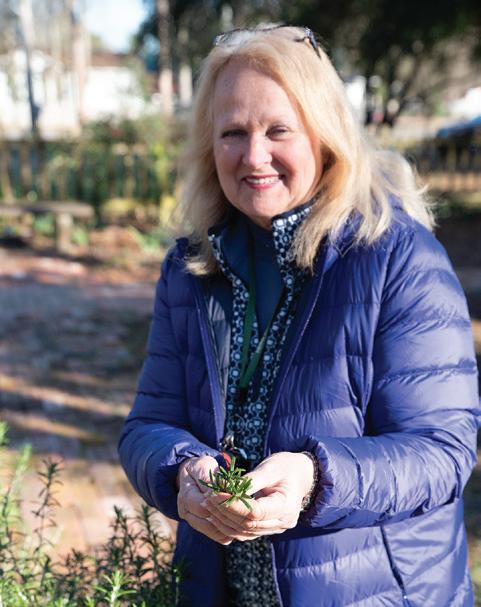
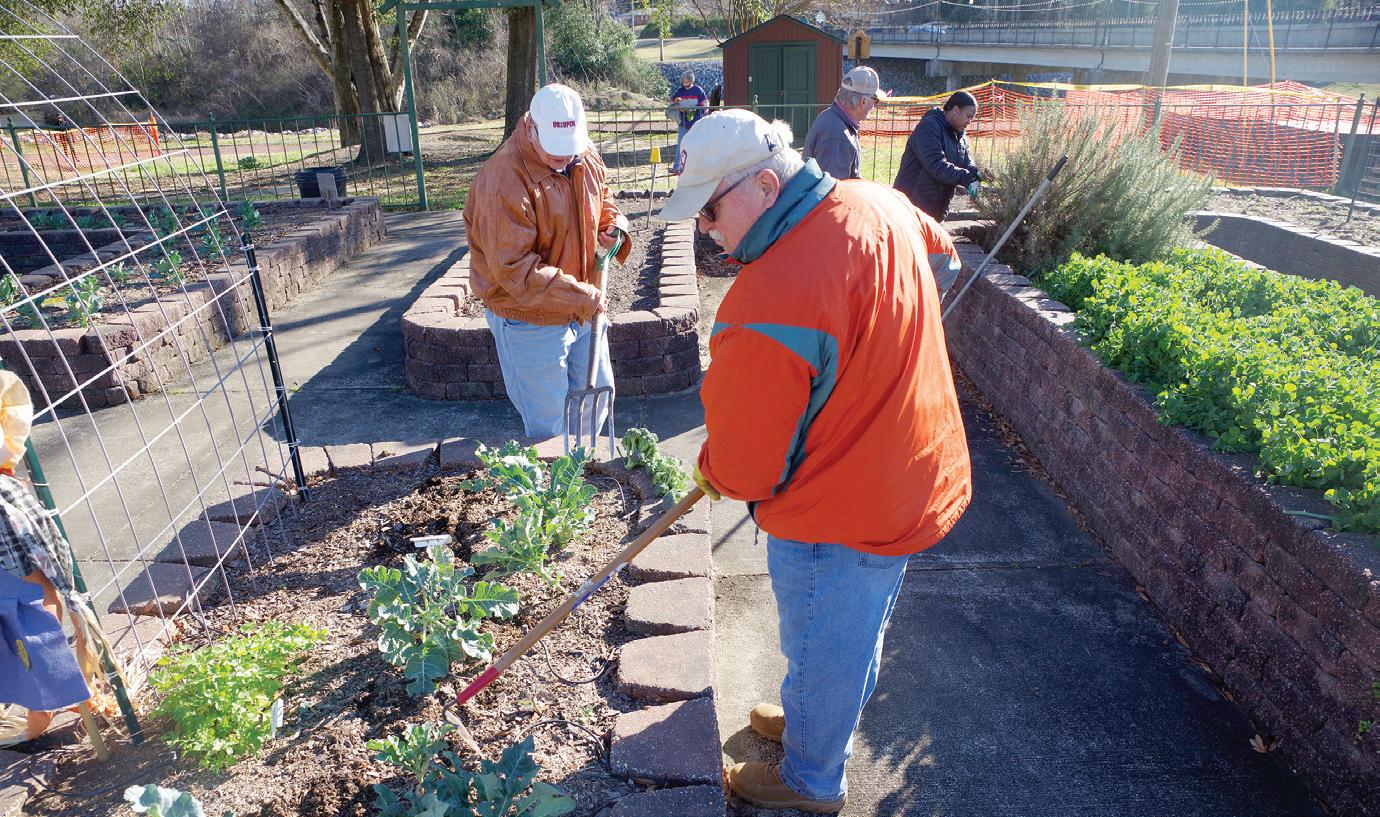
According to Smith, starting small alleviates a lot of novice gardening stress when things go wrong, and things always go wrong whether it’s too much or too little rain or an infestation of pests. “If only a few things are going wrong in a small space, they can be fixed,” she says. “But if you have a 20 x 20 garden and everything is going wrong, that is disappointing, frustrating and overwhelming.”
Choosing a small number of plants is also helpful. “Gardening is like going to a buffet,” Smith continued. “You want to try everything. But if you pick a few things you really enjoy, the experience is much better.”
Starting small also reduces waste — fewer plants dying as you get your green thumb into shape, for example — and it’s a great way to put fresh food — or herbs or flowers — on your table. Growing your own vegetables has many other advantages, too, such as allowing you to control what chemicals are used on your food.
But it’s not necessarily a money-saving endeavor.
“There’s no way with current food prices that it will be cheaper to grow your own vegetables,” O’Rear says. “But the satisfaction of harvesting your dinner or lunch is priceless.”
“Fresh just tastes better,” Smith agreed, adding that gardening is a great way to get children interested in healthy food, and it’s educational. “Look at all the things they can learn. There’s math, science, colors, flavors and textures.”
There’s so much to be gained from gardening, which is why O’Rear and Smith hope last year’s gardeners will stay in the game and new gardeners will join the team in 2021. And she and Smith are just two of many coaches ready to help. “Whether it’s growing lettuce in a pot or tomatoes in a five-gallon bucket, if we can get you to grow one something, that’s one more something you haven’t grown before,” O’Rear says.
And from there, the madness begins.


For master gardeners Robbie and Sheila Allen of Auburn, tending to their home gardens is a year-round job. At top, Robbie Allen tills the vegetable garden in early February. Above, a selection of wildflower seeds the Allens will plant soon. Below, Sheila Allen clears out a garden.
PHOTOS BY JULIE BENNETT

Extension agents answer questions on gardens — and more
Apparently, staying at home raises questions. Lots of them.
That’s certainly what happened this past March and throughout the rest of 2020 as pandemic-bound folks focused all their cooped-up energy and curiosity on their immediate surroundings. Luckily, experts with answers to those questions were just a click or call away through the Alabama Cooperative Extension System.
ACES, which was officially established in 1915 to offer science-based information aimed at improving the livelihoods and lives of farmers and rural residents, is the outreach arm of Alabama’s land-grant institutions — Auburn and Alabama A&M universities in cooperation with Tuskegee University.
For more than 100 years (Tuskegee’s outreach program dates back to the 1890s) Extension has made its information available to rural and urban Alabamians alike using a network of county and state offices where experts are ready with guidance on topics as diverse as gardening and farming, food safety and financial literacy, wildlife and quality of life.
While always busy, ACES experts saw an exponential rise in calls, emails and texts last year from people asking about topics ranging from backyard wildlife to food preservation and much more. Lawns and gardens, however, were a major topic of interest as stay-at-home orders made yards and outdoor spaces the go-to places for exercise, stress relief and fun.
One of those experts was Birmingham-based Regional Extension Agent Bethany O’Rear, whose phone was lighting up and dinging with calls and texts almost as soon as the state shutdown, mostly from people asking questions such as “I’ve never grown vegetables before, what do I do?”
As she and other agents across the state fielded calls, so did master gardeners — ACES-trained volunteers who provide horticultural information to their communities. Several master gardeners saw an opportunity to not just educate people about gardening but also share the wealth of a garden with others in need.
Soon, their ideas and the obvious need for a central source of ACES gardening

PHOTO BY DANNY WESTON
information came together in Grow More, Give More, a web-based resource filled with links to myriad publications, videos, blogs, lists and even helpful phone apps that can be used by beginning and experienced gardeners alike. The site also offers suggestions for sharing garden bounty with neighbors, including links to area and regional food banks and pantries.
According to O’Rear, the Grow More, Give More site was a way to make gardening as easy as possible — “We even compiled shopping lists,” she says — for new gardeners by providing research-based Extension information in one location. And she stressed that this information is based on rigorous scientific studies, which is important because “You know, you can’t believe everything you read on the Internet.”
In addition to this online resource, real live human help is also available through ACES agents located in all of Alabama’s 67 counties. Their contact information, including cell phone numbers, is available on the ACES website. “We have our cell phones with us all the time,” O’Rear says. “You can call us. That’s what we do.”
Answers are also available through the master gardener helpline at 1-877-ALAGROW or at GMGMhelpline@aces.edu. And, O’Rear notes, if ACES doesn’t have the answer you need, Extension organizations in nearby states with similar growing conditions are fabulous resources, too.
Here’s a list of links to ACES’s resources:
• Alabama Cooperative Extension
System site, including links to county offices and thousands of other resources: aces.edu • Grow More, Give More: aces.edu/
blog/topics/products-programslawn-garden/grow-more-givemore/
• ACES YouTube channel, which has videos on myriad subjects, from gardening to baking to controlling invasive species: youtube.com/user/
alcoopextensionvideo/playlists
• ACES soil testing and insect and plant disease diagnostic services:
offices.aces.edu/plantlabauburn/
• SOW-A Planting Companion app, which can help identify the optimum planting dates for vegetable crops • Farming Basics app, which is geared for small and beginning farmers but has valuable information for gardeners, too: aces.edu/blog/
topics/ipm-farming/farmingbasics-mobile-app/
• The Alabama Master Gardener
Program: mg.aces.edu • Alabama Public Television’s
“Spotlight on Agriculture” episode on ACES and 4-H, which offers an overview of Extension’s many roles and services: aptv.org/watch/
spotlight-agriculture/
PIXABAY
By Pamela A. Keene
Enjoying your garden’s harvest all year long
There’s nothing better than using home-canned tomatoes eration for choosing the proper canning technique depends on in an Italian recipe or pulling out a quart of fresh-frozen the acidity of the food you’re canning. For instance, higher-acpeaches to make a bubbly cobbler. However, if the only id foods like fruits can be processed in a water-bath canner. But thing you know about food preservation is your grandmother’s foods with a lower acid content, such as meats and soups, must be jam-making on a hot summer afternoon, you’ve got a whole lot of preserved using a pressure canner.” catching up to do. Some foods, such as tomatoes can be preserved using a wa-
“People have been preserving food for centuries, but as we learn ter-bath, but it’s important to add citric acid or lemon juice to more about foodborne acidify them. Pickles, beillness and spoilage, and cause of the added vinegar, changes in our food supply can also be canned using a and developments in can- water-bath if a tested recining equipment take place, pe is followed. recommendations are up- “For a beginner, we sugdated frequently to provide gest canning peaches or reliable ways to safely reap making applesauce to bethe bounty of our garden’s come comfortable with the harvest,” says Elizabeth An- equipment and the prodress, Ph.D., director of the cess,” Andress says. “Both National Center for Home use the water-bath methFood Preservation and od, which involves placfood safety specialist with ing filled containers into a the Georgia Cooperative large pot of boiling water Extension. “Food preserva- that covers the whole jar tion knowledge and techniques need to be based on sound food science for Fruit are a favorite for homemade jams and jellies. See more on our related recipe pages, 44-47. COURTESY NATIONAL CENTER FOR HOME FOOD PRESERVATION-UGA and lid and boiling them for the exact time shown in the recipe. Whenever safety; we’re still targeting canning, we recommend the same bacteria in canning as we have for a long, long time.” using a tested recipe from a reliable source, such as the National
From the garden to the table, food handling and kitchen hygiene Center for Food Preservation.” standards are crucial to successful food preservation. Because on- Yellow peaches can be peeled, cut into halves or slices, packed going research reflects updated methods, Andress strongly sug- into jars then covered with water or sugar syrup before putting on gests that consumers use the most recent information available. the lids and placing into the boiling water. “Choose between raw pack or hot pack when you fill the jars,” Canning basics she says. “With the raw pack, put the freshly peeled and slice
Preserving food by canning presents several options. “Each has peaches into a clean hot jar, then cover with hot syrup. Hot-pack its benefits and drawbacks, but in any case, it’s important to follow canning means that you cook the peaches in syrup first, the instructions exactly and familiarize yourself with each before then fill the jars with the hot fruit and liquid before attempting to can at home,” Andress says. “An important consid- processing.”


Applesauce can be processed using a water bath as well. Use the hot-pack method for filling the jars.
“When putting on the lids, be sure to wipe the jars’ sealing edges with a clean, damp cloth to remove bits of food that may prevent the jars from sealing properly,” Andress says.
Freezing
“If you grow basil or oregano in the summer, just chop the fresh leaves and put them into ice-cube trays covered with water,” she says. “Once they’re frozen, package them in a freezer-safe container, then when you need some herbs for soup or a sauce a recipe, take out the frozen cube and add it to the sauce. You can also do this for smaller quantities of hot peppers or onions.”
Certain foods freeze Getting back to better than others. “Many kitchen basics vegetables are not suited Canning and freezfor freezing, such as cu- ing have long been used cumbers, radishes, raw po- to preserve food. Today’s tatoes or onions,” Andress conveniences have made it says. “On the other hand, easier to enjoy the rewards vegetables like green beans of growing your own food and asparagus, and fruits long after the harvest is like blueberries or peaches over. are easy to freeze.” “Because of the pandem-
Green beans, corn, car- ic, more and more people rots and broccoli need to are turning to home food be blanched—submerged growing and preservation,” in boiling water for the she says. “Just be certain prescribed time on the rec- to follow all the guideipe—before freezing. Then they can be transferred to Red bell pepper and corn are reacy to made into canned relish. COURTESY NATIONAL CENTER FOR HOME FOOD PRESERVATION-UGA lines and recipes exactly. Don’t take any shortcuts or an ice bath for rapid cool- change ingredients or timing, drained and packed into containers. ing. The recipes we provide through the National Center for Pres-
“Once they’re blanched and drained, place them in a single lay- ervation have been extensively tested. The key is to be meticulous, er on a cookie sheet and freeze them individually,” Andress says. whether you’re canning or freezing. That way you can be assured “Then pack into freezer-safe containers, label and store.” of the freshest flavors and the safest results.”
Fruits such as blueberries, cherries, grapes, fresh sliced peaches and strawberries can simply be placed on cookie sheets and al- Resources: lowed to freeze individually before packing. Remove as much air Alabama Cooperative Extension System, aces.edu. The Exas possible before sealing. tension System has a number of videos on food preservation
“Fruits can be frozen with or without added sugar or liquid, de- and often does live events on its Facebook page at facebook. pending on what you plan to use them for,” she says. “Freezing can com/acesfoodsafety. be an easy way to preserve food. However, the same safe-handling guidelines apply. Keep your work surfaces clean, wash your hands often and carefully label the packages with the date processed and the contents.” USDA Complete Guide to Home Canning, nchfp.uga.edu/ publications/publications_usda.html National Center for Home Food Preservation, how-to information, plus recipes for canning, freezing, making jams, jellies and pickles, nchfp.uga.edu
Herbs can be frozen as well.

Left to right, pears ripe for picking; after peeling and slicing, pears are boiled with sugar for several hours; finished product – pear preserves.
PHOTOS BY MARK STEPHENSON



Before you plant, know your soil
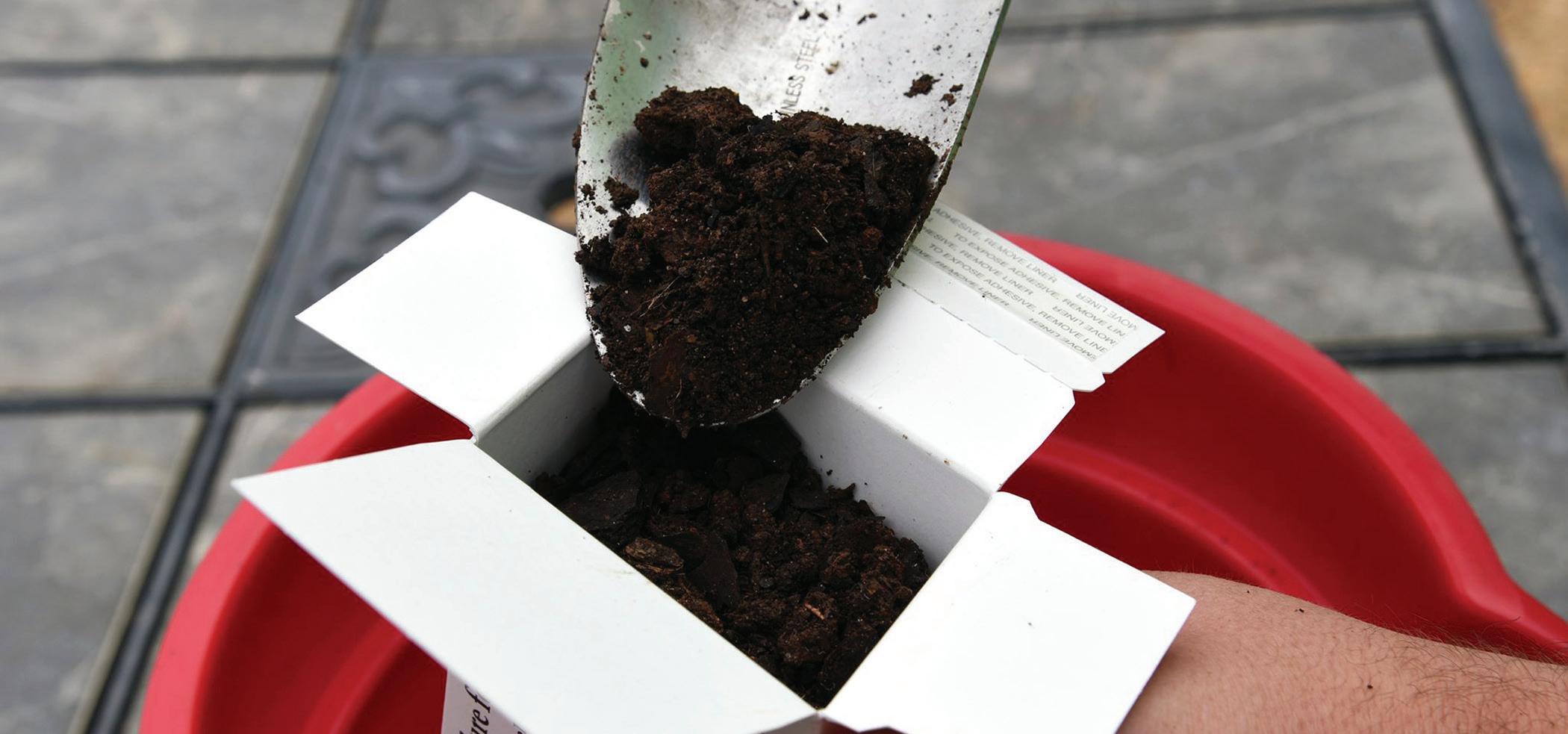
Before you start to plant your garden, trees, shrubs or lawn, it’s important to know what kind of soil you’re dealing with. The Alabama Cooperative Extension System has detailed instructions on its website to help the home gardener take a proper soil sample, which can then be sent to Auburn University’s Soil Testing Laboratory for analysis.
Because every square foot of soil can be different, and the acidity and nutrients of your soil can vary, it’s important that you take a composite sample of the area to be tested. A composite sample is a collection of 15 to 20 uniform cores or slices of soil taken from random spots in a garden, lawn, or shrub bed.
For an accurate test, place the samples from a given area into a clean bucket. Then mix this soil well and place about 1 pint of the mixture into a soil sample box. Soil sample boxes, information sheets, and other supplies for soil testing are available from your county Extension office or garden center.
The following recommendations can help you collect the proper soil samples:
Gardens, new lawns, and other cultivated areas. Take a uniform core or slice of the soil to the depth that the soil was tilled. Use a zig-zag pattern of sampling. Mix 15 to 20 of these cores or slices for the composite sample. Home orchard. A general recommendation will be made for common fruit crops grown in Alabama (peaches, plums, pecans, pears, apples, figs, grapes, strawberries, blackberries, and blueberries).
Lawn. List the specific type of grass to be fertilized (bermuda, zoysia, St. Augustine, centipede, bahia, fescue, bluegrass, carpetgrass, etc.).
Shrubs and perennial flowers. These include most evergreen and deciduous shrubs and small trees as well as flowering shrubs such as azaleas, camellias, rhododendrons, and gardenias. Perennial flowers such as irises and daylilies will also fit into this group. Some shrubs such as azaleas, camellias,and gardenias need an acid soil to prevent iron deficiencies while others need a higher soil pH for best growth. A list of some of the shrubs to be grown will help the laboratory make the best liming recommendations.
Roses, mums, and annual flowers. This group of ornamentals receive slightly higher fertilizer recommendations.
Potted plants. Soil testing is not recommended for potted ornamentals for the homeowner. A diagnostic service is available for large-scale commercial growers of potted plants.
When mailing your samples, enclose the filled soil boxes, the information sheet, and a check or money order ($7 per sample) to cover service charges in a cardboard shipping box. You may also pay by credit card by calling 334-844-3958. Tie the box securely and prepay by parcel post to:
Lawns and established turf. Take a uniform core or slice 2 to 3 inches deep from 15 to 20 spots in the lawn. Take separate samples for the front lawn, back lawn, and other areas where soil may differ or where a different type of grass is grown.
Trees and shrubs.Take uniform cores or slices 6 inches deep from around the drip-line of plants (outer edge of branches). Mix individual cores into a composite sample.
Fill in the information on the soil sample box and the information sheet as completely as possible. You must also indicate which plants are to be grown so that fertilizer recommendations can be made.
Follow these guidelines:
Vegetable garden. A general recommendation will be made that will be adequate for most garden vegetables. If you have an “organic” vegetable garden and would like a recommendation that does not include chemical fertilizers, please specify “organic vegetable garden.” Soil, Forage and Water Testing Laboratory 961 S. Donahue Drive Auburn University, AL 36849-5411
After you submit a soil sample, you will receive a report that includes the test results and recommendations based on those results. The appearance of the report will depend on the number of samples you submit and the type of plants you are growing. The report will include information on your intended crop(s), the soil group your sample belongs to, soil pH, results/extractable nutrients, nutrient rating, lime and fertilizer recommendations, as well as comments specific to your crop.
Information provided by the Alabama Cooperative Extension System.

Tips for planting an efficient, no-till garden
By Pat Keegan and Brad Thiessen
Q: It’s almost time to plant our garden, and we’re wondering if there are steps we can take to save energy when planting. How can we make our home garden more efficient?
beds. Start by laying weed-blocking material on top of the old dirt. Sheets of cardboard are often used because they will decompose over time. Then spread at least 4 inches of weed-free soil or compost on top. A: We’re glad you asked! One approach to gardening we’ve been excited about lately is no-till, also known as no-dig. No-till If the soil under the cardboard is reasonably loose, you can probably start planting right away. Your garden may be less progardens have been gaining ground with farmers in recent years, ductive the first year, but will grow healthier and have less weeds partly because of the energy savings. The principles behind no-till every season from then on. If the ground is heavily compacted or gardening work well clay, you may have for large farms, as to till in some comwell as smaller home post or healthy soil gardens. No-till can before laying down be done without the cardboard and chemicals. Research give it a year for the shows that this ap- new mix to get loosproach can produce er. more fruits and veg- In the fall, you can etables within a few cut the dead plants years, and they get at ground level and better over the long leave the roots in the term. Best of all, this ground to decomapproach to garden- pose over the winter. ing takes less time You may also want and effort––and you to plant a cover crop, won’t even have to like peas, fava beans fire up the rototiller! or barley late in the
Two ideas are at growing season. Setthe heart of no-till ting up a no-till gargardening. First, den takes a fair bit don’t break up the soil. We usually No-till growing can be done on commercial farms as well as home gardens. PHOTO COURTESY USDA of work, but it will require less maintethink that by break- nance in the future ing up the soil and mixing it up, we keep weeds from growing. and get healthier every year. But tilling can bring weed seeds that are deep in the soil to the If you’re ready to try your hand at planting a no-till garden, top where they can germinate and grow. Tilling also destroys mi- many colleges and universities offer extension classes for folks crobes in the soil that bring nutrients to the plants. who are not enrolled as students. You can also watch a variety of
The second idea is to spread thick layers of compost and other videos online that can guide you through setup and long-term mulch on top of the soil. When compost and other mulch are care. spread on top, they feed the soil from above, the same way leaves Here are a few additional tips that can help you reduce energy in a forest fall to the ground, decompose and turn into rich soil use related to gardening: over time. When you build up the soil by spreading layers of com- • Drip systems lose less water to evaporation. post and other mulch on top, the weed seeds are kept dormant. • Timers are a convenient way to control irrigation, but be sure Mulch keeps the soil moist, so less water is used to irrigate, which to override the timer and shut off watering cycles when a rain means less electricity use for pumping water from your well or shower can do the job. community water system. • Consider purchasing a rain barrel for energy efficient water-
Your no-till garden can be planted at ground-level or in raised ing. • Learn how to store your produce to reduce waste. Patrick Keegan writes on consumer and cooperative affairs • Make sure your freezer is energy efficient.for the National Rural Electric Cooperative Association, the Arlington, Va.-based service arm of the nation’s 900-plus consumer-owned, not-for-profit electric cooperatives. Write to We hope these tips will help you prepare for a more energy effienergytips@collaborativeefficiency.com for more information. cient garden this season. Happy planting––and eating!
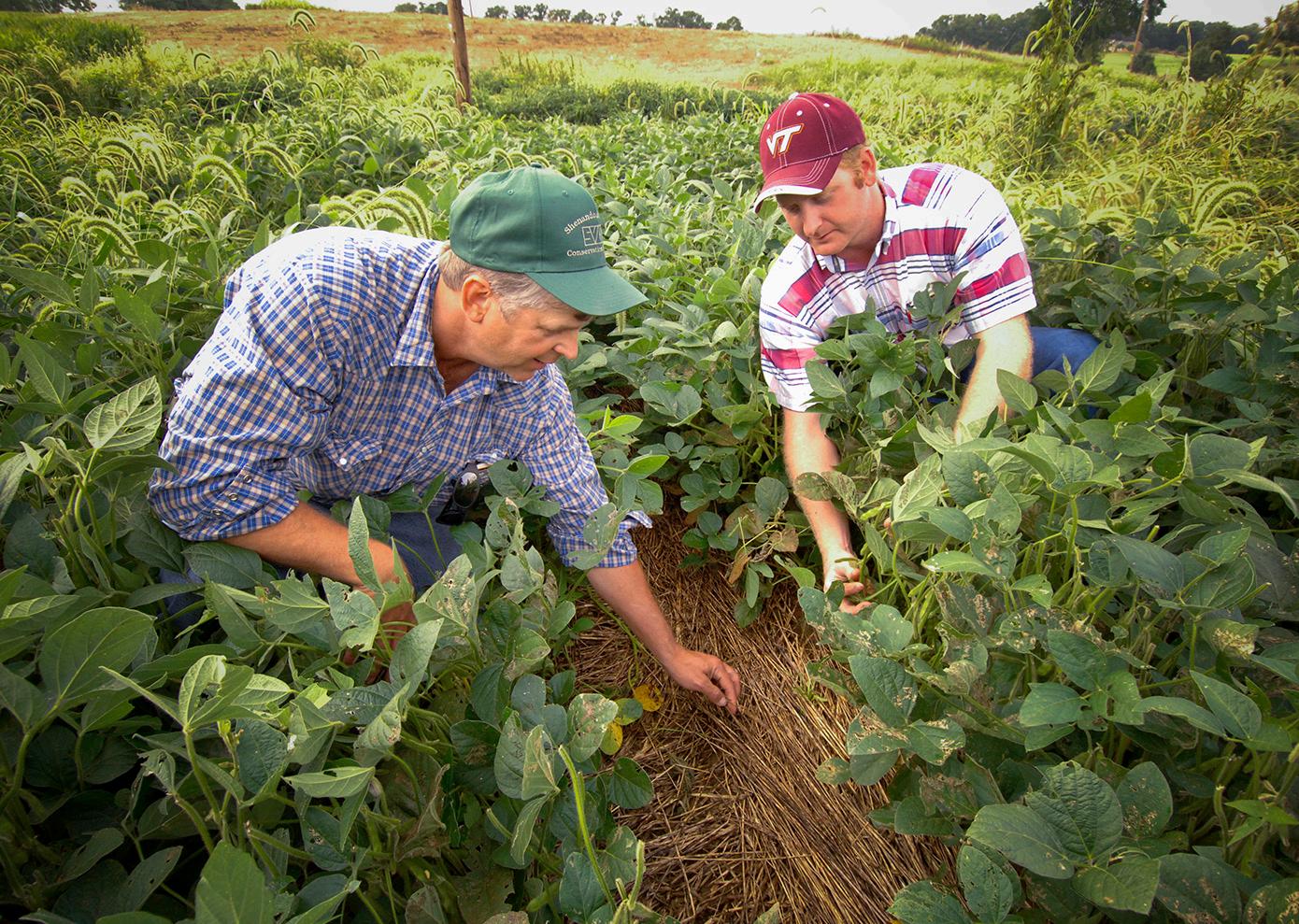


Sunshine Mills
continues to please pets around the world
By Emmett Burnett
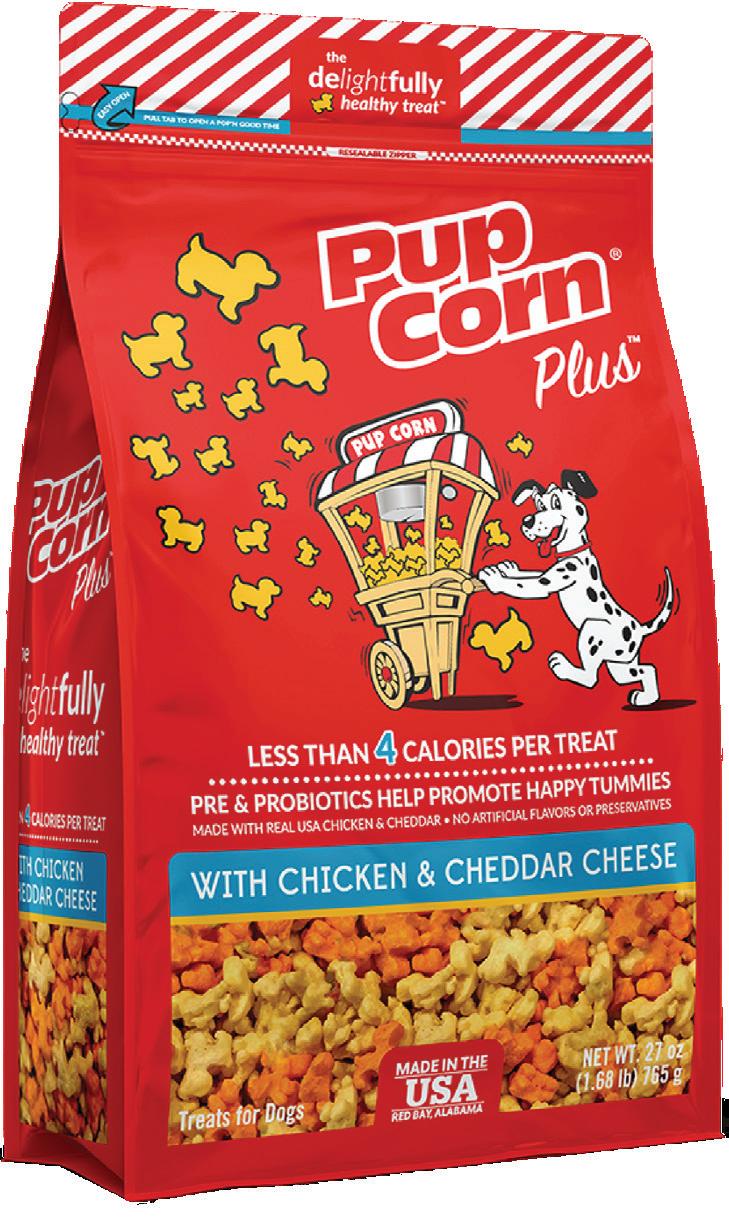
With a population of about 3,000, geographically near the with Kellogg’s Cornflakes misfits.” top of the state, you may be unfamiliar with Red Bay, From basic beginnings, the recipe was tweaked, tested, and dogs Alabama. But your dog would love it. Red Bay is small loved it. The Bryan brothers of Tupelo, Mississippi (today known town with a giant industry – pet food from Sunshine Mills. To ca- as Bryan Foods) could not supply pork cracklings fast enough. nine companions it is synonymous with Crunchin’ Bones, Meaty Sunshine added commercialization equipment, refined ingrediTreats, Pup Corn Plus, and more – much more. ents, and expanded product lines commercially and geographically
From Red Bay’s corporate headquarters, Sunshine Mills em- and in pellets. ploys 900 workers in 6 states. It produces dozens of pet food prod- Fred’s sons, John and Alan Bostick, joined the team. John came ucts under the company name and for private brand labels. It start- on board in the 1970s. He helped develop the company’s economy ed with two men, a dream, dog foods into more complete lines. Alan Bostick became CEO and a wheelbarrow. and president in 1984.
The duo was Omer What started in a J. Bullen and his son- 1961 wheelbarrow is in-law, Fred Bostick Jr. now a company shipOmer began the com- ping pet food around pany in the 1940s as the world. Red Bay a wholesale grocery alone produces about business with a small 750,000 pounds of animal feed trade. Fred dry pet food every came on board in 1947. 24 hours. In 1961 they took the “That’s with food for dogs business all lines running by the collar. which is most of
Ralston Purina was the time,” says getting into the dry plant manager pet food game and so Chris Seahorn. would Fred, albeit on “Most of the a smaller scale. “My time everything father made the first is going.” batch of Sunshine Seahorn notMills dry dog food ed typically the in a wheelbarrow,” plant runs 7 company president days a week in and CEO Alan Bos- the winter but tick recalls. “It was a less in summer combination of pork – consumer decracklings, animal fat-oil, and salt, mixed Pup Corn Plus dog treats, left, are low in fat and made with real chicken, salmon or bacon. The Evolve brand is Sunshine Mills’ super premium pet food line. mand falls in hot months but re-


turns in the winter. The reason? Dogs eat less in the summer.
“Pet food is a seasonal business,” Bostick adds. “During warmer weather, dogs develop shorter coats, shed fur, and lose appetites. During winter, the opposite occurs. Days grow shorter which triggers a dog’s instinct to eat more and gain weight to get through winter.”
However, business spiked in the early days of COVID-19 as customers stockpiled pet foods just as they did human food.
Feeding finicky felines
says. “It reflects the humanization of pet food. Pet owners want fine meat, gluten- and GMO-free ingredients. They want it to be more like human food.” Its brands Evolve Pet Food sold in grocery stores, Triumph Pet Food in pet specialty stores, and Sportsman’s Pride in farm & feed stores have a passionate fanbase locally and on social media. According to the Humane Society, the U.S. has 86 million dogs and 78 million cats. They are potential customers. The huge four-legged customer base is partly why Sunshine Mills has grown since the
In 1984, Sunshine Mills took on a new first batch of pet food poured from Fred client – cats. “Producing food that a cat Bostick’s wheelbarrow. likes is almost an art from,” Bostick says His son Alan refers to the growth as “one with a smile. “They are finicky and require stepping stone at a time.” In addition to the more research.” At times, cats are frustrat- two Red Bay locations, other Sunshine sites ing. include Tupelo, Mississippi, Dublin, Geor-
“We can test a new product on 10 cats,” gia, Greenville, N.C., Halifax, Virginia, and the CEO continues. “Eight may love it but Elkhart, Indiana. Sunshine Mills also ships two will hate it. Then you tweak it and the product to 30 countries. two former haters love it but now the other With its significant strides in the pet food 8, don’t like it.” industry, corporate headquarters could be
Sunshine Mills’ production is about 80 anywhere but remains in Red Bay. “This is percent dog food and 20 percent cat food, where we started,” Bostick says. “I grew up simply because dogs are bigger and eat more. One might think once a pet food recipe Sunshine Mills employs 900 workers in six states, but its headquarters remains in Red Bay, Alabama. here and my dad lived here. This is home.” Pets from China to Guatemala have enjoyed Sunshine Mills products but none exfor main meals or chewy treats is estab- emplify “lucky dogs” and “cool cats” more lished and the finished product tested, eaten, and endorsed by hap- than Bostick’s pets. “I have 5 dogs and 9 cats. They usually receive py wagging tails, everyone lives happily ever after. But the pet food something from the mill every day.” business has two customers: First, dogs have to love it and they Recently one of his cats took a liking to a company product indo. But unless you are Scooby Doo, dogs have little discretionary tended for his dogs. “We are going to study this,” he notes. income. People do. Perhaps another new Sunshine Mills product development is in
“Today’s customers want premium pet food foods,” Bostick the works, only this time, without a wheelbarrow.

Alan Bostick, son of one of Sunshine Mills’ founders, became CEO and president in 1984.
